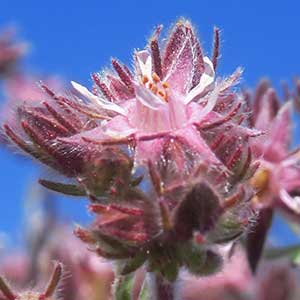Horkelia tenuiloba
Horkelia hendersonii
Santa Rosa, Santa Rosa horkelia, Sonoma horkelia, thin-lobed, thin-lobed horkelia
Henderson's horkelia
ascending to erect, 1–4 dm, hairs ± spreading.
ascending to erect, 0.8–2(–2.5) dm.
weakly planar to ± cylindric, 5–15(–20) × 0.5–1.5 cm;
stipules entire;
leaflets 8–16(–20) per side, ± overlapping especially distally, cuneate to flabellate, 3–10 × 2–10 mm, 1/2 to nearly as wide as long, divided 1/2–3/4+ to midrib into 3–8 linear to narrowly oblanceolate or narrowly elliptic lobes, sparsely villous at least marginally, often with a tuft of hairs apically.
3–8 × 0.7–1.5 cm;
leaflets (5 or)6–12 per side, overlapping at least distally, cuneate to flabellate, 4–9(–10) mm, divided 1/2+ to midrib into 3–6 oblanceolate to obovate lobes (often medially notched more than 3/4 to midrib as well), silky villous.
2–5.
2–3.
open to congested, flowers arranged individually and in glomerules, these sometimes subcapitate.
1–6 mm.
2–8(–10) mm.
10 mm diam.;
epicalyx bractlets narrowly to broadly lanceolate, 1–3 × 0.5–1 mm, slightly shorter than sepals, entire;
hypanthium 1–1.2 × 2.5–4.5 mm, less than 1/2 as deep as wide, interior pilose;
sepals spreading to reflexed, lanceolate, 3–5 mm;
petals oblanceolate, 2.5–4.5 × 1.5 mm, apex emarginate;
filaments (1–)1.5–2 × 0.5 mm, anthers 0.4–0.6 mm;
carpels 10–25;
styles 1.8–2.2 mm.
(2–)4–15(–20), 10 mm diam.;
epicalyx bractlets linear, 2.5–4.5 × 0.2–0.5 mm, 2/3 to nearly equal to length of sepals;
hypanthium 1–2.5 × (2–)3–4(–5) mm, ± 1/2 as deep as wide, interior densely villous;
sepals spreading, narrowly lanceolate, 3.5–6 mm, silky hairs silky, 1–1.5 mm;
petals often pink-tinged, linear to narrowly oblanceolate, 2.5–5 × 1 mm, apex ± acute to narrowly rounded, sometimes slightly mucronate;
filaments pinkish, 2 × 0.5–0.7 mm, glabrous or sparsely pilose adaxially, anthers 0.5–0.7 mm;
carpels 8–17;
styles (1.5–)2–3 mm.
light brown, 1.5 mm, smooth or slightly rugose.
dark brown, 2 mm.
= 28.
Horkelia tenuiloba
Horkelia hendersonii
Of conservation concern.
Horkelia tenuiloba occurs on the western edges of the northern Coast Ranges in Marin, Mendocino, and Sonoma counties. Populations from San Luis Obispo formerly included in this species now are part of H. yadonii. A specimen (M. K. C[urran], July 5, 1885, UC) unequivocally of H. tenuiloba purportedly from San Luis Obispo is in all likelihood mislabeled with respect to locality.
Horkelia tenuiloba is commonly associated with seral openings in chaparral and woodlands and might be dependent on periodic disturbance by fire.
W. L. Jepson (1909–1943, vol. 2) used Potentilla stenoloba (1895) for the species encompassing the types of Horkelia tenuiloba and P. micheneri. The epithet micheneri (1893) has priority at species rank within Potentilla, since P. tenuiloba (Torrey) Greene is a later homonym of P. tenuiloba Jordan.
(Discussion copyrighted by Flora of North America; reprinted with permission.)
Of conservation concern.
Horkelia hendersonii is one of the more attractive species of the genus, with its grayish mats and dusky pink inflorescences. P. A. Rydberg (1898) placed it initially in his group Capitatae, here restricted to H. fusca, and later (1908c) transferred it to his new group Tenuilobae, which otherwise comprised only H. tenuiloba. The species is known only from Jackson County, Oregon, and an isolated population in adjacent Siskiyou County, California. The populations are vulnerable due to their proximity to popular recreational sites.
(Discussion copyrighted by Flora of North America; reprinted with permission.)


